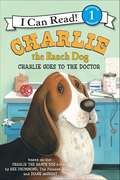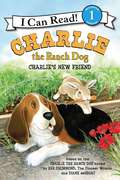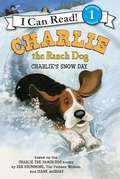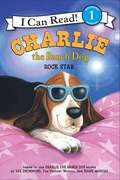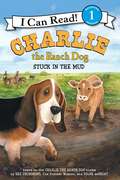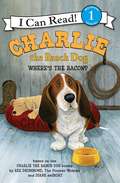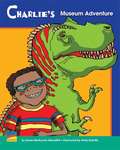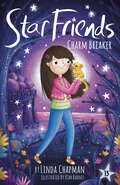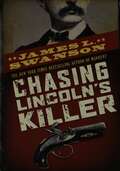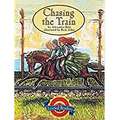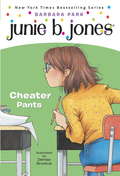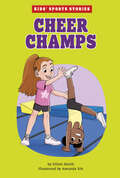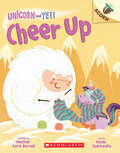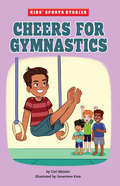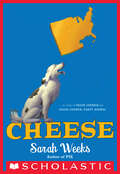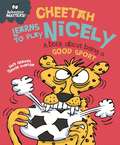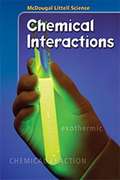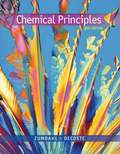- Table View
- List View
Charlie the Ranch Dog: Charlie Goes to the Doctor (I Can Read Level 1)
by Ree DrummondCharlie is the lovable basset hound of the Pioneer Woman, Ree Drummond, and the star of the #1 New York Times bestselling picture book Charlie the Ranch Dog. Now our favorite bacon-loving dog is back in this new I Can Read story! Mama knows something's wrong with Charlie the Ranch Dog when he's not even hungry for bacon! So they're off to see Dr. Jan. Even though Charlie is nervous about his visit to the doctor, he's not half as scared as Hickory, the puppy he befriends in the waiting room. As the older hound, can Charlie put on a brave face for Hickory?With his usual hilarious antics, Charlie overcomes his fears about the doctor . . . as will the kids who read this book! This Level 1 I Can Read is perfect for children learning to sound out words and sentences.
Charlie the Ranch Dog: Charlie's New Friend (I Can Read Level 1)
by Ree DrummondRee Drummond, the Pioneer Woman and #1 New York Times bestselling author of Charlie the Ranch Dog, is back with a new I Can Read story featuring our favorite bacon-loving basset hound. Charlie the Ranch Dog may have met his match in Mr. Rabbit, a sneaky ranch animal that steals from Mama's garden. Charlie tries to think up ways to stop the rabbit from eating up all the yummy carrots, but Mr. Rabbit always seems to be one step ahead!Charlie's New Friend is a Level One I Can Read book, which means it's perfect for children learning to sound out words and sentences. With expressive illustrations by acclaimed artist Diane deGroat and Charlie's hilarious antics, this I Can Read story will become a favorite of parents and beginning readers.
Charlie the Ranch Dog: Charlie's Snow Day (I Can Read Level 1)
by Ree DrummondCharlie the Ranch Dog stars in New York Times bestselling author Ree Drummond's I Can Read title, just right for reading on your own snowy day! When Charlie wakes up to a world covered in snow, he can't wait to go outside. He even takes a break from patrol duty to go sledding with his friends Walter and Sister. But when Walter goes missing, it's up to Charlie to take control of the situation and bring his buddy back.Charlie's Snow Day is a Level One I Can Read book, which means it's perfect for children learning to sound out words and sentences.
Charlie the Ranch Dog: Rock Star (I Can Read Level 1)
by Ree DrummondCharlie is the lovable basset hound of the Pioneer Woman, Ree Drummond, and the star of the #1 New York Times bestselling picture book Charlie the Ranch Dog. Now our favorite bacon-loving dog is rocking and rolling in this new I Can Read story! Charlie the Ranch Dog is ready to live the good life—as a rock star! But as he tries to settle into the lifestyle of the rich and famous, Charlie discovers that sometimes the ranching life is best! This Level One I Can Read book is perfect for children learning to sound out words and sentences.
Charlie the Ranch Dog: Stuck in the Mud (I Can Read Level 1)
by Ree DrummondCharlie is the lovable basset hound of the Pioneer Woman, Ree Drummond, and the star of the #1 New York Times bestselling picture book Charlie the Ranch Dog. Now our favorite bacon-loving dog is back in this new I Can Read story! It's not easy being a cattle dog, but Charlie knows he's the right dog for the job! When Abigail the calf gets stuck in the mud, Charlie springs into action . . . until he gets stuck, too! How will Charlie get out of this sticky situation? This Level One I Can Read is perfect for children learning to sound out words and sentences.
Charlie the Ranch Dog: Where's the Bacon? (I Can Read Level 1)
by Ree DrummondKids already love Charlie the Ranch Dog from the #1 New York Times bestselling picture book by Ree Drummond, the Pioneer Woman. Now hard-working, bacon-loving basset hound Charlie is starring in his own I Can Read series! In Charlie the Ranch Dog: Where's the Bacon?, a new dog comes to visit. Things get off to a bad start. Rowdy doesn’t understand Charlie is the boss of the ranch. He sleeps in Charlie’s bed, drinks Charlie’s water, and worst of all, he eats Charlie’s bacon. Charlie has to get Rowdy under control. And he really needs to find more bacon! Where’s the Bacon? is a Level One I Can Read book, which means it's perfect for children learning to sound out words and sentences.
Charlie’s Museum Adventure
by Susan Markowitz Meredith Anita DuFallaThis story is about Charlie's trip to the museum and how he compares dinosaurs to animals of today.
Charm Breaker (Star Friends)
by Linda ChapmanIn the 13th installment of the Star Friends series, Mia, Lexi, Sita, Violet, and new Star Friend Maddie suspect dark magic when they noticed that the adults in town are at first very energetic and spontaneous but then become reckless. Can the girls figure out what's going on?The town of Westport is sponsoring a charity run, and everyone participates. But after the run, Mia, Lexi, Sita, Violet, and the newest Star Friend, Maddie, notice that many of the adults in town are at first very energetic and spontaneous but then gradually become reckless. Maddie observes that her mom hasn't been affected, and she wonders why. And as the adults' actions intensify, the girls suspect dark magic. Where is it coming from? With black-and-white illustrations throughout.In the Star Friends chapter book series, Mia and her friends Lexi, Sita, and Violet all discover that they are Star Friends -- they can communicate with the animals that have traveled from the Star World. The animals show the girls how to use their unique magic abilities to do good. A whole world of magical adventures awaits!
Chasing Lincoln’s Killer: The Search For John Wikes Booth
by James L. SwansonNIMAC-sourced textbook
Cheater Pants (Junie B. Jones #21)
by Barbara Park<P>Junie B. Jones has all the answers when it comes to cheating. It's just plain wrong! <P>But what about copying someone else's homework? That's not cheating, right? 'Cause homework isn't even a test! And speaking of tests . . . what if a friend shares an answer that you didn't even ask for? Sharing definitely isn't cheating . . . is it? Uh-oh. Maybe this cheating business is more complicated than Junie B. thought. Could she be a cheater pants and not even know it?
Cheer Champs (Kids' Sports Stories)
by Elliott SmithLeah wants to use her gymnastics skills by joining the cheer squad. Leah is deaf, and she worries that this will make cheer difficult. She struggles to keep up with the count of the routine in the first practice. Then Leah meets Monica, who offers to help. Will the girls be able to come up with a plan so the team can nail the routine on competition day?
Cheer Up: An Acorn Book (Unicorn and Yeti #4)
by Heather Ayris BurnellMagical friends Unicorn and Yeti love to help each other!Pick a Book. Grow a Reader!This series is part of Scholastic's early reader line, Acorn, aimed at children who are learning to read. With easy-to-read text, a short-story format, plenty of humor, and full-color artwork on every page, these books will boost reading confidence and fluency. Acorn books plant a love of reading and help readers grow!Unicorn has a gift for Yeti. Yeti does not have one to give to Unicorn. Yeti loves to crunch icicles. Unicorn wants to try crunching them, too! Yeti thinks the dark forest is pretty. Maybe Unicorn needs to see the forest from a different perspective? These sparkly, laugh-out-loud stories with full-color artwork and easy-to-read text throughout are perfect for new readers!
Cheers for Gymnastics (Kids' Sports Stories)
by Cari MeisterMateo is used to being the best member of his gymnastics team. When a new boy with stronger skills joins, Mateo's jealousy threatens to knock everyone off balance right before the big Winter Challenge event.
Cheese: A Combo of Oggie Cooder and Oggie Cooder, Party Animal (Oggie Cooder Ser.)
by Sarah WeeksTwo hilarious adventures in one volume starring “a loveable character . . . Fans of Jeff Kinney’s Wimpy Kid titles will be drawn to Oggie” (School Library Journal).Oggie Cooder loves cheese so much that he carries a slice of cheese with him wherever he goes. It’s not just for a snack—Oggie is an excellent charver. (Charving is when you chew a piece of cheese to carve it in the shape of something.) The kids at school think Oggie’s charving is a little strange. But when a big TV show comes looking for people with unusual talents, Oggie is suddenly Mr. Popular. Can Oggie charve a path to fame and score an invite to the party of the year without melting under the pressure? No matter how you slice it, you’re going to laugh when you read about one small kid becoming a really big cheese, in this hilarious combination of Oggie Cooder and Oggie Cooder, Party Animal.Praise for Oggie Cooder“Oggie’s adventure delivers a message about staying true to oneself, but the lesson is never cheesy; it is as light-hearted and tasty as Oggie’s charving lessons.” —Kidsreads.com“What is refreshing is that Oggie doesn’t have to change his nature to change his social status. Gentle humor with a satisfying message for middle-grade readers.” —Kirkus Reviews
Cheetah Learns to Play Nicely - A book about being a good sport (Behaviour Matters #23)
by Sue GravesThis funny, charming story is the perfect way to introduce young children to what fair play is, and help them understand the importance of being a good sport. Also included are suggestions for activities and ideas to talk through together to help children fully understand how their behaviour can impact on others.Cheetah always wants to win - no matter what it takes. But when his friends no longer want to play with him, he decides to look at his behaviour and start playing more nicely.The Behaviour Matters series of picture books provide a gentle means of discussing emotions, boosting self-esteem and reinforcing good behaviour. Supports the Personal, Social and Emotional Development Area of Learning in the Early Years Foundation Stage, and is also suitable for use with children in KS1 and can be used to discuss values. Suitable for children under 5.
Chemcom Chemistry in the Community (Third Edition)
by A Project of the American Chemical SocietyAn introductory chemistry lab book for high school students.
Chemcom Chemistry in the Community (Third Edition): Chemistry In The Community; A Project Of The American Chemical
by A Project of the American Chemical SocietyAn introductory chemistry lab book for high school students.
Chemical Interactions
by Lawrence Hall of Science University of California at BerkeleyNIMAC-sourced textbook
Chemical Interactions Resources: Images, Data, and Readings
by Lawrence Hall of ScienceThis book explores chemicals, for instance, their formation, reactions and properties.
Chemical Interactions: FOSS Science Resources
by Lawrence Hall of Science University of California at BerkeleyNIMAC-sourced textbook
Chemical Matter: Activity Book (Amplify Core Knowledge Language Arts, Grade 5 #Unit 9)
by Amplify EducationNIMAC-sourced textbook
Chemical Principles (Eighth Edition)
by Steven S. Zumdahl Donald J. DecosteDevelop the qualitative, conceptual foundation you need to think like a chemist with CHEMICAL PRINCIPLES, 8e. Designed for students with solid mathematical preparation, this best-seller emphasizes models, everyday applications of chemistry, and a thoughtful, step-by-step problem-solving approach.
